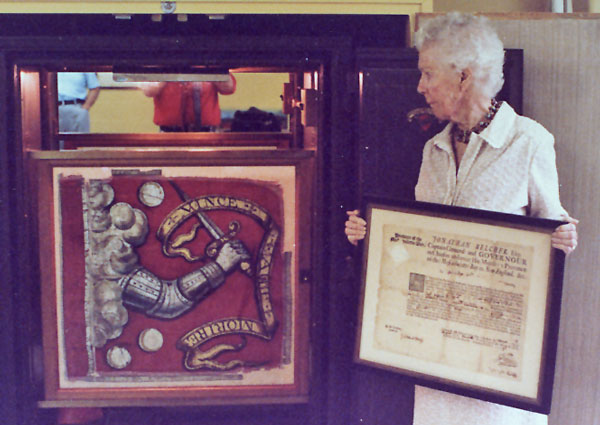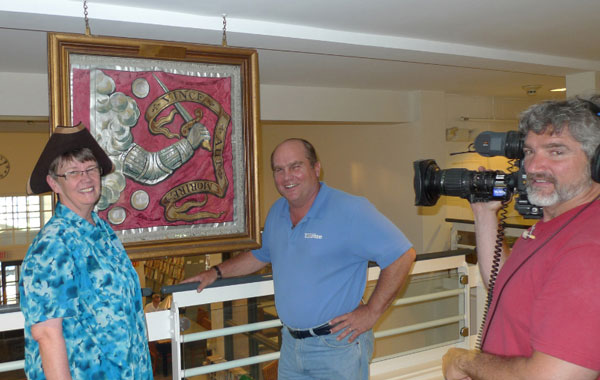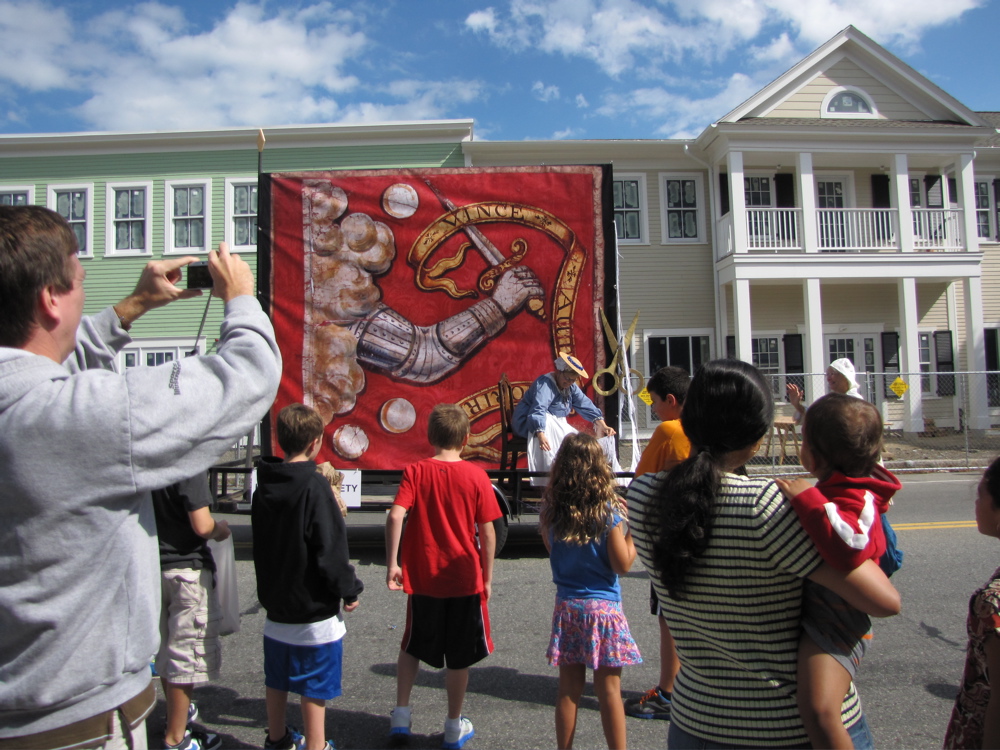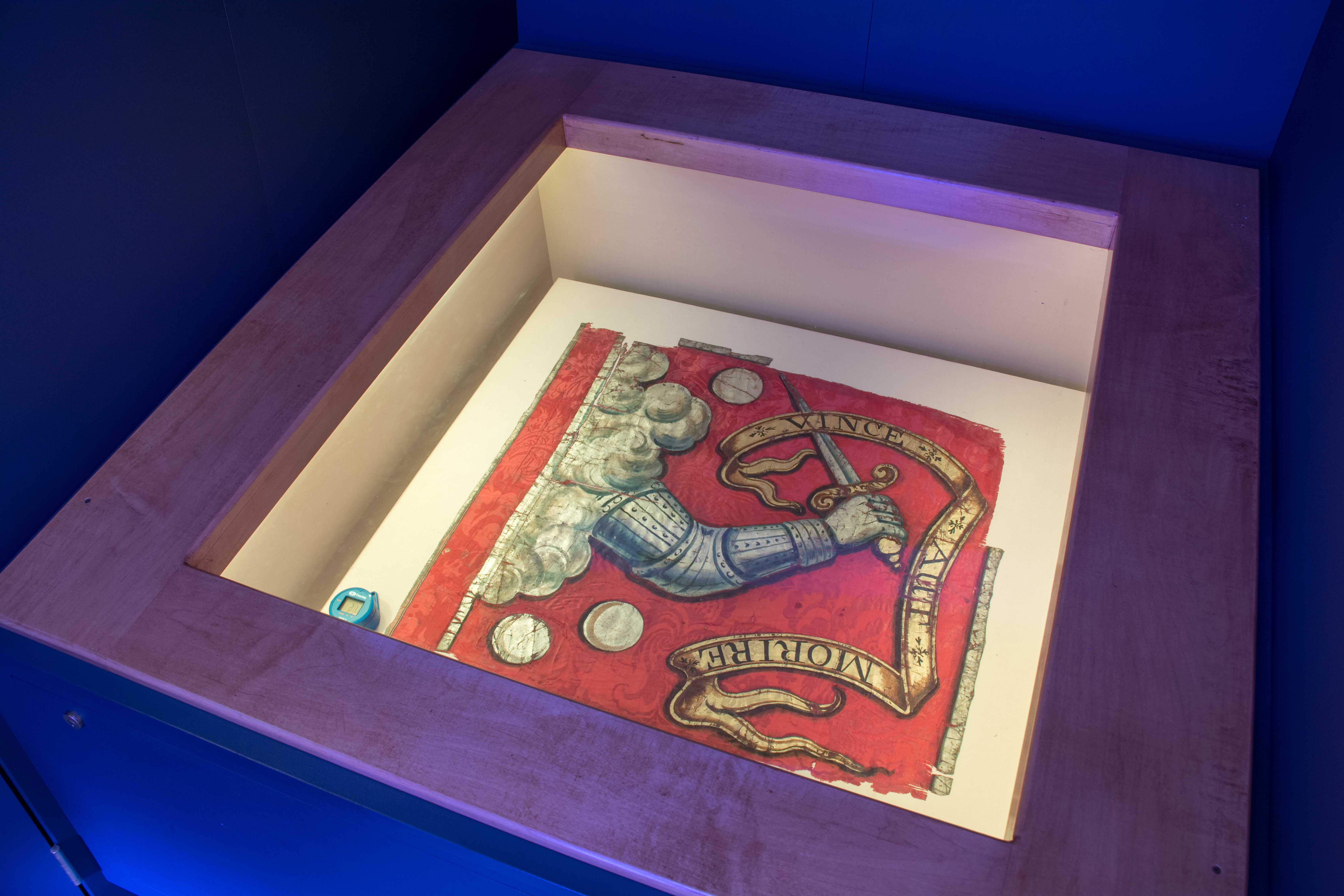Bedford Flag
A National Treasure
A colonial militia flag preserved in the Bedford Free Public Library, Bedford, Massachusetts
 The Bedford Flag is the oldest complete flag known to exist in the United States. It is celebrated as the flag carried by the Bedford Minuteman, Nathaniel Page, to the Concord Bridge on April 19, 1775, the beginning of the American Revolution, but it was already an antique on that day. It was made for a cavalry troop of the local Massachusetts Bay militia early in the eighteenth century.
The Bedford Flag is the oldest complete flag known to exist in the United States. It is celebrated as the flag carried by the Bedford Minuteman, Nathaniel Page, to the Concord Bridge on April 19, 1775, the beginning of the American Revolution, but it was already an antique on that day. It was made for a cavalry troop of the local Massachusetts Bay militia early in the eighteenth century.
The flag is a piece of crimson silk damask measuring about 27” long by 29” wide. This small square shape indicates that it was a cavalry flag. Into the rich red damask is woven a pattern of pomegranates, grapes, and leaves. The design is painted on both sides of the flag, mainly in silver and gold. The emblem consists of a mailed arm emerging from clouds and grasping a sword. Three cannonballs hang in the air. Encircling the arm is a gold ribbon on which the Latin words “VINCE AUT MORIRE” (Conquer or Die) are painted. On the reverse of the flag, the design is slightly different: the sword extends in front of the ribbon instead of behind; it is held left-handed; and the motto is read from bottom to top instead of top to bottom.
A narrow area would have been folded and stitched to make a sleeve for the pole to go into. Some of the holes the needle made are still faintly visible. All but a single thread from the silver fringe that once edged the flag has been lost to history. That one strand was discovered microscopically during the flag’s 1999-2000 conservation at the Textile Conservation Center in Lowell, Mass. Evidence was also found that there may once have been a tassel attached at the hoist side of the flag.
Want to View the Flag?
The original Bedford Flag is secured in a special room on the Flag Balcony of the Bedford Library, where it is protected from heat, light and humidity. It may be viewed at any time the Library is open. To see the flag, please ask at the Library Circulation Desk or the Reference Desk.
In exchange for your driver’s license or other secure deposit, you will be loaned a magnetic key that will admit you to the Flag Room. Passing the key in front of the red light beside the door handle will unlock the door.
As viewing space is limited, only five people may be in the Flag Room at once. Keep the door closed as much as possible to maintain the protective atmosphere within the room.
Please no flash photography in the Flag Room! Light is destructive to the aged red silk.
We hope you enjoy seeing our historic flag along with the accompanying display. Postcards of the flag and the book The Bedford Flag Unfurled may be purchased at the Circulation Desk. Proceeds benefit the Library.
Origin of the Flag
Exactly who made the flag and when it was made are not known. Physical and historical evidence point to an origin early in the eighteenth century. The distinctive floral pattern woven into the damask has been dated by textile experts
Page Family Received the Flag
When did the Page family first receive the flag? Displayed in the Flag Room in the Bedford Free Public Library is an original commission dating 1737. It names Minuteman Nathaniel Page’s father John “Cornett of the Troop of horse.” A cornet was the cavalry officer just below lieutenant whose duty it was to bear the flag.
Carrying the Flag
In fact, Nathaniel’s father, uncle and grandfather are all mentioned within the Bedford and Billerica Town Records as “Cornet Page,” indicating that a Page had been carrying the flag for the local militia troop as early as 1720. It was the custom in the English militia for the colonel of the regiment or the new captain of a unit, not the cornet, to arrange for the flag. Thus it was not a member of the Page family but an officer of higher rank who designed and procured the flag.
Start of American Revolution
Carried by the Bedford Minuteman, Nathaniel Page, to the Concord Bridge on April 19, 1775, the beginning of the American Revolution
Flag during the Revolutionary War
The flag was still in the custody of the Page family at the time of the American Revolution, and it is believed in Bedford that Minuteman Nathaniel Page took it with him to the battle at Concord. Nathaniel told the story to his grandson, Cyrus, and it was written down after his death by the nineteenth century historian, Abram English Brown. This account says:
“Our people were not surprised when the messenger reached this house… We had agreed at the last drilling to meet, in case of alarm, at the tavern in the center of the town, kept by Jeremiah Fitch, sergeant of the militia company. The horseman banged on the house and cried out, ‘Up, Mr. Page, the regulars are out.’ We were not long at our preparations, and were soon at the tavern.”
A. E. Brown continues, “On the arrival of the [Bedford] Company at Concord, they assisted in removing the stores to places of greater safety. Tradition says that Cornet Nathaniel Page laid down his flag and went to work, and when returning to look for it ‘found the boys had got it and were playing soldiers.’” He took it up and went to face the British regulars at the North Bridge.
While there is no contemporary account to corroborate this story, Nathaniel Page is listed in the official military rolls of the men who were paid for service in the American forces on April 19th. The flag is more than old enough to have been there with him on that day. His father, uncle and grandfather had served as cornets in the militia. Did Nathaniel bear the flag to Concord as he said he did? That is clearly quite possible.
After the War
Nathaniel’s youngest daughter Ruhamah went so far as to rip the fringe from it. She later lamented to A. E. Brown, “I took that silver fringe from that old flag when I was a giddy girl, and trimmed a dress for a military ball. I was never more sorry for anything than that which resulted in the loss of the fringe.”
Flag sent to Concord
The first Cornet Page’s great-great-grandson, Cyrus Page, sent the flag to the centennial celebration at Concord
Flag presented to Town of Bedford
Just before Page’s death, he presented the flag to the Town of Bedford, into the keeping of the trustees of the Bedford Free Public Library. Cyrus desired that this “relic of by-gone days” should be “kept for the inspection of the public at all proper times.” It has remained in the care of the library to this day.
The Flag Balcony
The building of an addition to the Library afforded an opportunity for a new display space for the flag. At the that time the flag was sent to the Textile Conservation Center at the American Textile History Museum in Lowell for cleaning and repair. After a three year hiatus, the flag returned to the library and is now housed in a climate controlled secure room accessible only by a key card. The flag balcony displays the story of the flag, a reproduction of the flag used in the bicentennial ceremonies, and photos of the preservation process.
Funding for the preservation and display of the flag was provided by the Bedford Library Corporation and the Friends of the Bedford Flag.




